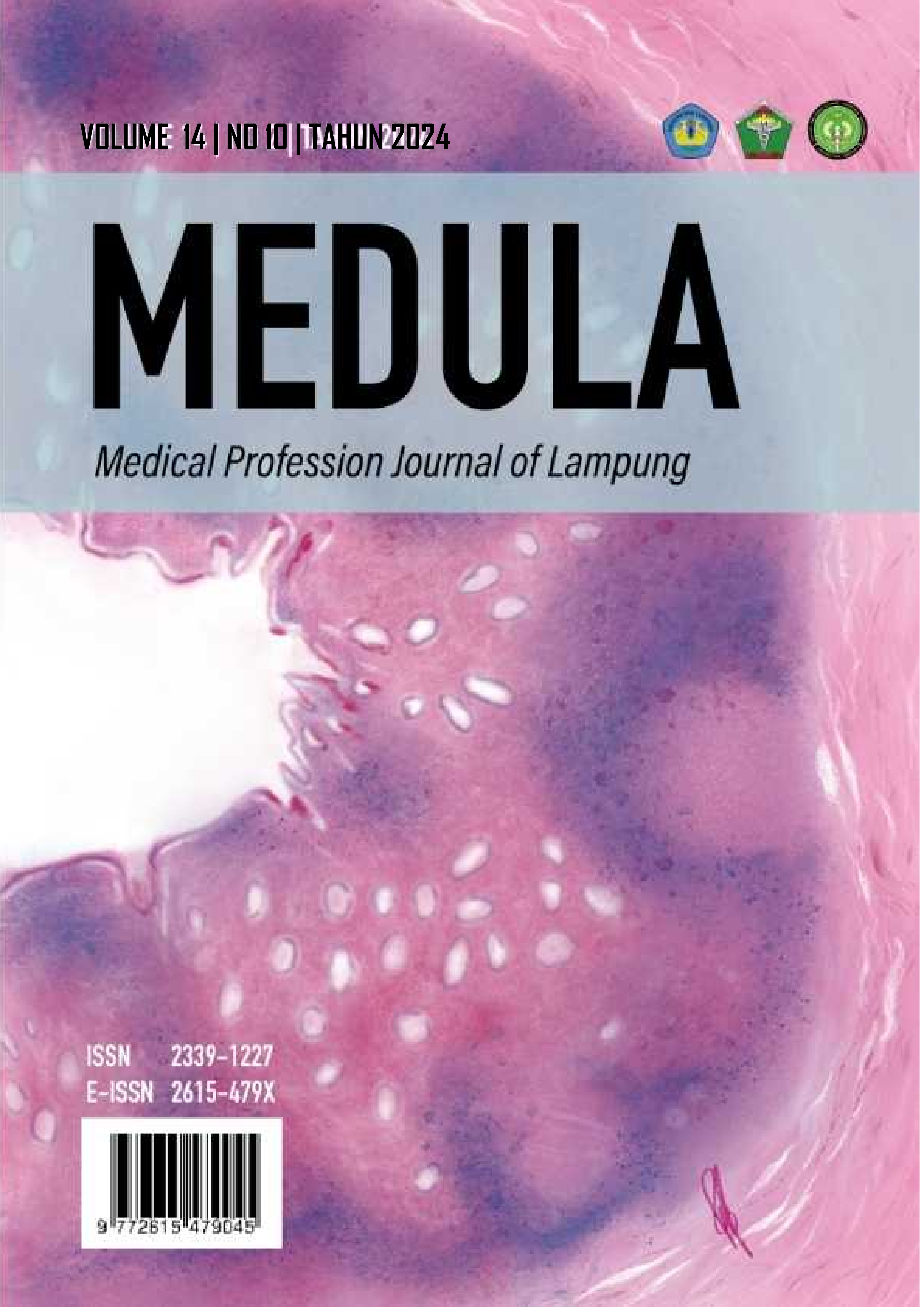Transmission and Risk Factor of Helicobacter pylori Infection in Gastritis: Literature Review
Transmisi dan Faktor Risiko Infeksi Helicobacter pylori pada Gastritis: Literature Review
DOI:
https://doi.org/10.53089/medula.v14i10.1368Keywords:
Keywords: Gatritis, Helicobacter pylori, Transmission, Risk FactorAbstract
Gastritis a common health issue with high prevalence both globally and nationally. Acute gastritis often associated with lifestyle factors and stress, while chronic gastritis is primarly caused by infection of Helicobacter pylori. This review aims to provide a detail understanding of Helicobacter pylori transmission and risk factor for its infection. This review is a narrative literature review that comparing multiple studies about the topic. Literature was gathered from various database and analyzed to find relevant findings. Result of this study indicate that Helicobacter pylori transmission occurs trough multiple routes such as fecal-oral and oral-oral. Hygiene status and sociodemographic conditions are the most significant risk factor that influence this infection. Chronic gastritis a prevalent condition often caused by Helicobacter pylori infection. Risk factors for this infection include low socioeconomic status, poor hygiene, inadequate sanitation, and exposure to contaminated environments. H. pylori bacteria can persist for extended periods in specific environments, such as water, food, and dairy products, but struggle to survive in acidic conditions, such as found in yogurt. The prevalence of infection notably higher among children living in areas with poor sanitation and unhygienic food practices. Prevention strategies involve enhancing hygiene standards, improving sanitation, ensuring access to clean water, and promoting health education to minimize the risk of transmission. Early treatment is crucial to restore the gastric mucosa's health and prevent further damage.
References
Azer SA, Awosika AO, Akhondi H. Gatritis. StatPearls Publishing; 2024.
Yin Y, Liang H, Wei N, Zheng Z. Prevalence of chronic atrophic gastritis worldwide from 2010 to 2020: an updated systematic review and meta-analysis. Ann Palliat Med. 2022;11(12):3697-3703. doi:10.21037/apm-21-1464
Kementerian Kesehatan Indonesia. Laporan Riskesdas 2018 Nasional.; 2018.
Park JS, Jun JS, Seo JH, Youn HS, Rhee KH. Changing prevalence of Helicobacter pylori infection in children and adolescents. Clin Exp Pediatr. 2021;64(1):21-25. doi:10.3345/cep.2019.01543
Sipponen P, Maaroos HI. Chronic gastritis. Scand J Gastroenterol. 2015;50(6):657-667. doi:10.3109/00365521.2015.1019918
Islamiah MR, Sukohar A. Cyclea Barbata Miers) Dalam Melindungi Mukosa Lambung Terhadap Ketidakseimbangan Faktor Agresif Dan Faktor Defensif Lambung. Majority. 2017;7(1):41-49.
Bui D, Brown HE, Harris RB, Oren E. Serologic Evidence for Fecal–Oral Transmission of Helicobacter pylori. The American Society of Tropical Medicine and Hygiene. 2016;94(1):82-88. doi:10.4269/ajtmh.15-0297
Smith SM. Helicobacter Pylori. Vol 2283. (Smith SM, ed.). Springer US; 2021. doi:10.1007/978-1-0716-1302-3
García A. Biofilm and Helicobacter pylori : From environment to human host. World J Gastroenterol. 2014;20(19):5632. doi:10.3748/wjg.v20.i19.5632
Brito BB de, Silva FAF da, Soares AS, et al. Pathogenesis and clinical management of Helicobacter pylori gastric infection. World J Gastroenterol. 2019;25(37):5578-5589. doi:10.3748/wjg.v25.i37.5578
Castro-Muñoz LJ, González-Díaz CA, Muñoz-Escobar A, et al. Prevalence of Helicobacter pylori from the oral cavity of Mexican asymptomatic children under 5 years of age through PCR. Arch Oral Biol. 2017;73:55-59. doi:10.1016/j.archoralbio.2016.09.007
Bai X, Xi C, Wu J. Survival of Helicobacter pylori in the wastewater treatment process and the receiving river in Michigan, USA. J
Water Health. 2016;14(4):692-698. doi:10.2166/wh.2016.259
Burucoa C, Axon A. Epidemiology of Helicobacter pylori infection. Helicobacter. 2017;22(S1). doi:10.1111/hel.12403
Endra Budi Setyawan F, Ira Fauziyyah L. Analisis Determinan Perilaku Dan Lingkungan Terhadap Kejadian Gastritis Pada Pelajar. Vol 1.; 2020.
Saftarina F, Sukohar A, Kurniawan B, Atina R. Optimalisasi Peran Kader Unit Kesehatan Sekolah (UKS) dalam Peningkatan Pengetahuan dan Keterampilan dalam Upaya Menjaga Perilaku Hidup Bersih dan Sehat (PHBS) pada Siswa dan Siswi SMPN 2 Bandar Lampung. JPM Ruwa Jurai. 2017;3:11-15.
Quaglia NC, Dambrosio A. Helicobacter pylori : A foodborne pathogen? World J Gastroenterol. 2018;24(31):3472-3487. doi:10.3748/wjg.v24.i31.3472
Kotilea K, Bontems P, Touati E. Epidemiology, Diagnosis and Risk Factors of Helicobacter pylori Infection. In: ; 2019:17-33. doi:10.1007/5584_2019_357
Amaral O, Fernandes I, Veiga N, et al. Living Conditions and Helicobacter pylori in Adults. Biomed Res Int. 2017;2017:1-5. doi:10.1155/2017/9082716
Zhou M, Zeng Y, Xi Y, et al. School-based Hygiene Intervention to Prevent HelicObacter Pylori infection among childrEn (SHIP HOPE): protocol for a cluster-randomised controlled trial. BMJ Open. 2022;12(12):e064207. doi:10.1136/bmjopen-2022-064207
Hadi S, Moyna Clara C, Yandri Y, Sukohar A, Suhartati T. Comparative Bioactivity Study of some Organotin (IV) 2-Chlorobenzoate compounds as Disinfectant agent. Res J Pharm Technol. Published online June 26, 2023:2885-2889. doi:10.52711/0974-360X.2023.00475
Downloads
Published
How to Cite
Issue
Section
License
Copyright (c) 2025 Medical Profession Journal of Lampung

This work is licensed under a Creative Commons Attribution-ShareAlike 4.0 International License.














